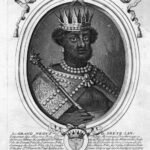SAMURA, SOLIMANGA
- 3 Min Read
Solimanga Samura (who flourished in about the 17th century) was a warrior traditionally famous for his enormous stature. He was believed by the Yalunka Samura of northern Sierra Leone and the Republic of Guinea to be the founder of their clan.
Originally called Dantili Samura, he is said to have been a Mandinka from Mende (in what is now Mali). But according to tradition, this huge warrior failed to make his mark in his own country and left it to seek fame and fortune elsewhere. He travelled southwards with his weapons of war until he reached Firia, the country of the Yalunka kamara north of Sierra Leone, where he met a Kamara blacksmith, Sa Yere, at work. Tired from his travels, Dantili sat down on a heap of wooden chips which had flown off the hoe handles (solidagina in Yakunka) that Sa Yere was carving.
Onlookers, ascribing qualities of leadership to this man of impressive build, soon started to call him manga (ruler) as he sat on the heap of chips. Thus he came to be called Solimanga, a fusion of solidagina and manga, and his original name Dantili soon fell into disuse.
While he was in Firia, the ruler, Fori Frigi (after whom the country was named), issued a proclamation that four warriors were attacking and robbing people in Firia. They were native Yalunka Kamara, but had disguised themselves and taken strange names in order to prevent identification. In his proclamation Frigi indicated that he would be indebted to anyone who could rid him of the warriors. Solimanga took up the challenge and killed them all.
Through this incident Fori Frigi discovered Solimanga’s presence in his country. In gratitude he gave him his daughter Mmame Yeri as his wife. Together with some other relations in the area, he also gave Solimanga a total of 700 males and as many males to form his retinue. These people were of different clans but none were Samura. Through living with them, Solimanga lost his Mandinka culture and became a Yalunka.
For a time he stayed within Firia, where the people were being harassed by the neighbouring Fula of Futa Jallon, in what is now the Republic of Guinea, Solimanga and his warriors drove away the Fula so that Fori Frigi was able to extend his territory over the conquered area. Frigi and Solimanga then agreed that the latter should keep any other territory he might conquer from the Fula. In this way Solimanga founded his first town, Kalota, in territory near Firia which he had rid of Fula.
Most of the Yalunka given to solimanga as followers readily took the clan name of Samura as a mark of honour and association with their leader. But Solimanga had only four sons – Yirisa Yella, Kumbasa, Yeri Fate and Yana Tagesa. They became the rulers of Solimankhori, (khori means ‘country’), the country surrounding Kalota and founded by Solimanga. Thereafter the Yalunka of Solimankhori regarded themselves as Solima Yalunka.
Solimanga died, probably in the later 17th century, and was succeeded by his son Yirisa Yella as ruler of Solimankhori. In the 18th century a state was founded by Yalunka of different clans, led by the Samura, descendants of Solimanga, and centred on Solimankhori. This state was called Solimana or the Solima state, with the capital Falaba. Today Falaba is still the principal town of the Solima chiefdom, named after Solimanga, in the Koinadugu district of Sierra Leone.
C. MAGBAILY FYLE




